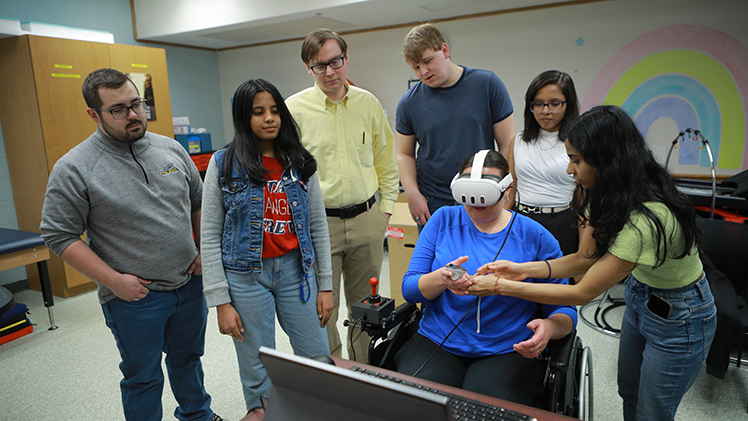A motorized wheelchair can be a game-changer.
Unfortunately, it can be a cumbersome process for a person with a physical disability to obtain one, explained Kelsey Garner, an occupational therapist at Sunshine Communities in Maumee, in large part because of the limited availability of demo models.

A team of undergraduate seniors developed a virtual reality tool to assess whether a person can safely maneuver a motorized wheelchair in collaboration with Sunshine Communities. From left, Evan Palmer, Simran Shekhar, Jeffrey Walter of Sunshine Communities, Nick Hemmert, Tika KC and Sakshi Dhumma watch as Sunshine’s Kelsey Garner tries it out at the nonprofit in Maumee.
So she and her colleagues brought an idea to The University of Toledo College of Engineering, where undergraduate seniors have long been applying skills they’ve learned in courses and co-ops to real-life problems like theirs: Could Sunshine Communities speed up and simplify their motorized wheelchair assessment process using virtual reality?
As five of these seniors will demonstrate this week at the College of Engineering’s Senior Design Expo, where visitors can try their hands at navigating the simulated hallways of the nonprofit using a joystick and a virtual reality headset, they can indeed.
“I was constantly telling the students, ‘I don’t think you have any idea what an impact this is going to make on our world,’” Garner said ahead of a final demonstration last week. “I’m really excited about this. It’s going to be huge for us.”
The virtual reality assessment tool will be one of more than 25 student-developed projects on display during the Senior Design Expo, a long-standing tradition and requirement for graduation in the college that showcases students’ creativity and ingenuity. Other projects this year include a program that identifies and translates sign language, a survey and site layout of a parcel of land acquired by Habitat for Humanity of Wood County, and a fiber-reinforced concrete bowling ball that won first place in the aesthetics category at an American Concrete Institute competition in Toronto in late March.
The Senior Design Expo, from noon to 3 p.m. Friday, April 25, on the first floor of Nitschke Hall, is a key part of the College of Engineering’s Design & Discovery Day. Programming that also incorporates faculty research presentations and alumni and industry professional panels is from 10 a.m. to 5 p.m. in Nitschke Hall and North Engineering.
For a full schedule and more information, go to the event website.
Sakshi Dhumma, Nick Hemmert, Tika KC, Evan Palmer and Simran Shekhar, all seniors in the Department of Electrical Engineering and Computer Science, said they were happy to collaborate with Sunshine Communities. The real-world impacts of their work proved a strong motivator to push through the inevitable challenges.
“That’s what was really driving us to make it work,” KC said.

Kelsey Garner, an occupational therapist at Sunshine Communities, tries out a new motorized wheelchair assessment tool developed by a team of undergraduate seniors at the College of Engineering.
The team worked closely with Garner and Jeffrey Walter, a technology integration specialist who graduated from the College of Engineering in 2022, to first identify the specific needs of the nonprofit that supports medically complex individuals with developmental disabilities through residential and transportation services, day programming, supported employment and multiple therapies.
Its mission is to create community among people with developmental disabilities, their families, friends and staff by offering services that enable all of us to build relationships that enhance our lives through mutual caring and growth.
Garner explained that before a person can obtain a motorized wheelchair, and, importantly, the increased independence that comes with it, occupational therapists first need to assess their ability to safely maneuver one using a joystick, head array or eye-tracking technology. If she and her colleagues could excise the need for demo models from this process, she hoped, they could complete these assessments more efficiently as well as more safely — there are lower stakes to a collision in virtual reality, after all.
Dhumma, Hemmert, KC, Palmer and Shekhar set to work recreating a hallway in the nonprofit facility using a game development software and engine called Unity, aiming for realism in the presence of obstacles ranging from furniture to staff who roam the virtual halls.
Community members participating in an assessment put on a virtual reality headset, then navigate the virtual world using a joystick similar to one that would power a motorized wheelchair. As they work their way down the simulated hallway, and eventually a maze of traffic cones the team designed as a maneuverability test, staff can track collisions and monitor their progress on a computer screen.
The project proved a learning curve for the team members, some of whom had never put on a virtual reality headset before tackling the project. In designing their assessment tool, they had to supplement the skills they’ve developed throughout their academic programs.
“We watched a lot of YouTube tutorials on Unity,” KC said.
Another takeaway from the project?
“I think the primary thing we learned is patience,” Dhumma said. “One day it’s working perfectly; the next day it breaks and we don’t know why. We had to keep figuring it out until it was a success.”